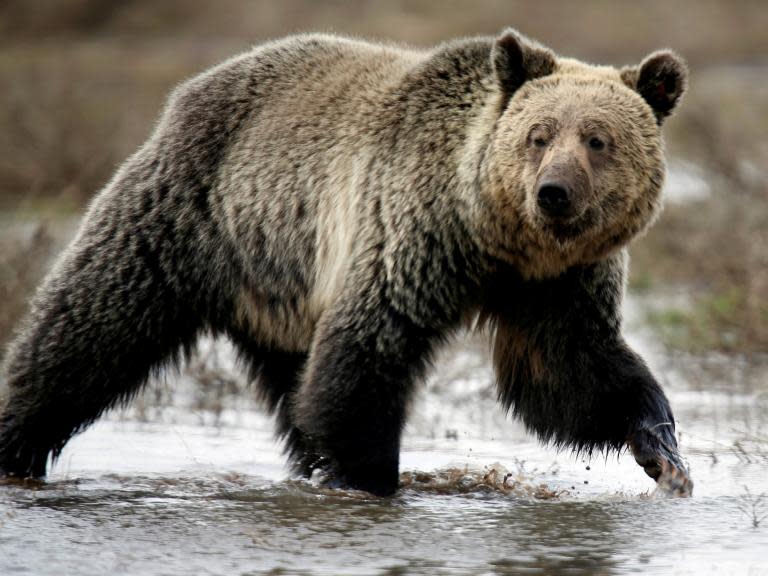First Yellowstone grizzly hunt in decades blocked by judge after Trump administration ends protection for bears
The first public grizzly bear hunt in the Rocky Mountains for decades has been temporarily blocked by a federal judge.
Dana Christensen ruled the hunting season, which had been due to open in Wyoming and Idaho this weekend, should be delayed while he considered whether the government was wrong to lift federal protections on the animals.
The order means planned hunts – the first in either state since 1974 – will be prohibited for 14 days.
“The threat of death to individual bears posed by the scheduled hunts is sufficient” to justify a delay in the states’ hunting seasons, Judge Christensen said.
The move was welcomed by wildlife protection campaigners, who joined Native American tribes in legal action over the US Fish and Wildlife Service’s (FWS) decision to lift federal protections for the roughly 700 grizzly bears in and around Yellowstone National Park.
“We’re thrilled,” said Mike Garrity, executive director for the Alliance for the Wild Rockies. “Now the judge has time to rule without grizzly bears being killed starting Saturday morning.”
Campaigners warned the bears’ survival in the region is at risk, but federal wildlife officials say the animals are thriving.
The bears were given federal protection in 1975, when only about 136 grizzlies remained in Yellowstone. The protection was lifted last year after their numbers rebounded.
Management of the bears falls on the states of Montana, Idaho and Wyoming.
Montana decided against allowing a trophy hunt this year, but the other two states have issued licences that would allow up to 22 bears to be killed. Thousands of people applied for licences.
Todd Hoese, a hunter from Gillette, Wyoming, expressed disappointment in the judge’s ruling and said grizzlies posed a threat to livestock and humans.
He said opponents of the hunt were “just looking at it from the bears’ perspective.”
He said: “The way that nature works is a balance and we don’t have that balance. There are too many bears now.”
Hunt opponents claim the FWS’s decision to de-list the Yellowstone grizzlies as a threatened species was based on flawed science. They added that do not trust the three states to ensure the bears’ survival.
Department of Justice lawyers said FWS had considered all the parties’ arguments and proceeded with lifting protections because there was no threat of extinction to the bears in the foreseeable future.
“The likelihood of any significant harm to the population is essentially nil,” said Erik Petersen, Wyoming’s senior assistant attorney general.
Mr Petersen and lawyers representing Montana and Idaho said the people most affected would be the farmers and ranchers who live in grizzly territory and have increasing conflicts with bears attacking livestock.
Those people have been co-operative with conservation efforts, but that attitude may change if federal protections are restored, they suggested.
The FWS first declared a successful recovery for the Yellowstone grizzly population in 2007, but a federal judge ordered protections to remain in place while wildlife officials studied whether the decline of a major food source, whitebark pine seeds, could threaten the bears’ survival.
In 2017, the agency concluded that it had addressed all threats and ruled that the grizzlies were no longer a threatened species needing restrictive federal protections.
That prompted six lawsuits challenging the agency’s decision and which were later consolidated into one case that Mr Christensen heard this week.
Should the hunts go ahead, it would be Wyoming’s first since 1974 and Idaho’s first since 1946. Twelve hunters in Wyoming and one in Idaho have been issued licenses.
Wyoming is to allow nine males or one female to be killed in prime grizzly habitat near Yellowstone and Grand Teton national parks, as well as 12 more bears in an outlying area.
Idaho, which has fewer grizzlies, will allow only one to be hunted. Montana last held grizzly hunts in 1991 under an exemption to the federal protections that allowed 14 bears to be killed each fall.


